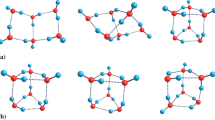Abstract
Results are presented for a molecular dynamics simulation of melting of the water hexamer from three-dimensional configurations (the book, cage, and prism isomers). The interactions between water molecules are described using two rigid potentials-TIP4P and TIP5P. The isomer geometry is determined using the connectivity matrix of the H-bond network graph. It is found in a numerical experiment that the Lindemann index, which shows the fluctuations in the length of intermolecular bonds, behaves similarly for all the studied initial isomers of the cluster. The melting of the cluster is found to depend on the interaction potential used in the study. For the cluster’s full energy, regions are identified which can be attributed to the premelting phase, which is dominated by the book isomer for TIP4P and ring isomer for TIP5P. The energy region attributed to the quasi-liquid phase of the cluster is shown to be characterized by isomers with ring and linear structures for both of the potentials.
Similar content being viewed by others
References
R. S. Berry and B. M. Smirnov, Phys. Usp., 52, No. 2, 137–164 (2009).
R. S. Berry, T. L. Beck, H. L. Davis, and J. J. Jellinek, Adv. Chem. Phys., 70,Part 2, 75 (1988).
H. Nada and J. Erden, J. Chem. Phys., 118, 7401 (2003).
W. B. Bosma and M. M. Rhodes, J. Chem. Phys., 117, 9286 (2002).
R. J. Saykally and D. J. Wales, Science, 336, 814 (2012).
E. D. Belega, K. A. Tatarenko, D. N. Trubnikov, and E. A. Cheremukhin, Zhurn. Khim. Fiziki, 28(5), 79 (2009).
P. Pirzadeh, E. N. Beaudoin, and P. G. Kusalik, Chem. Phys. Lett., 517, 117 (2011).
L. Verlet, Phys. Rev., 159, 98 (1967).
W. L. Jorgensen, J. Chandrasekhar, J. D. Madura, R. W. Impey, and M. L. Klein, J. Chem. Phys., 79, 926 (1983).
M. W. Mahoney and W. L. Jorgensen, J. Chem. Phys., 112, 8910 (2000).
A. M. Kutepov (ed.), Water: Structure, State, and Solvation. Advances in Recent Years [in Russian], Nauka, Moscow (2003).
F. A. Lindemann, Physik. Z., 11, 609 (1910).
S. Kirkpatrik, C. D. Gellat, and M. P. Vecchi, Science, 220, 671 (1983).
O. Ore, Colloquium Publications, vol. 38: Theory of Graphs, 3rd edition, American Mathematical Society (1962).
T. James, D. J. Wales, and J. Hernandez-Rojas, Chem. Phys. Lett., 415, 302 (2005).
Y. Zubavicus and M. Graunze, Science, 304, 974 (2004).
Author information
Authors and Affiliations
Corresponding author
Additional information
Original Russian Text © 2015 E. D. Belega, D. N. Trubnikov, E. A. Cheremukhin.
__________
Translated from Zhurnal Strukturnoi Khimii, Vol. 56, No. 1, pp. 59–64, January–February, 2015.
Rights and permissions
About this article
Cite this article
Belega, E.D., Trubnikov, D.N. & Cheremukhin, E.A. Melting of the water hexamer. J Struct Chem 56, 52–57 (2015). https://doi.org/10.1134/S0022476615010084
Received:
Revised:
Published:
Issue Date:
DOI: https://doi.org/10.1134/S0022476615010084



